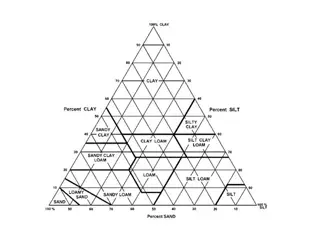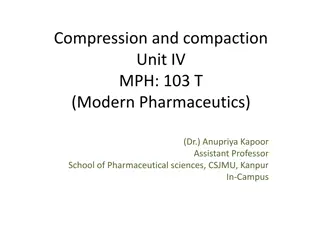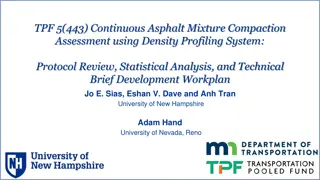Effective Methods for Soil Conservation
Methods to reduce soil erosion and promote soil conservation include terracing, contour planting, strip cropping with cover crops, alley cropping, agroforestry, windbreaks, and conservation tillage practices such as no-till and minimum tillage. These methods help in minimizing soil erosion hotspots
2 views • 11 slides
John Deere CR1448 CR1460 Compaction Roller Operator’s Manual Instant Download (Publication No.5DDP00369)
Please open the website below to get the complete manual\n\n\/\/
0 views • 12 slides
Understanding Diagenesis and Lithification in Sedimentary Rocks
Diagenesis and lithification are crucial processes that transform loose sediment into solid rock through compaction and cementation. Diagenesis involves various chemical, physical, and biological changes while lithification involves the pressure-induced consolidation of sediment. Compaction removes
0 views • 15 slides
Optimizing Asphalt Material Testing Procedures
This document outlines the sample preparation procedures for both IDEAL-CT and High-Temp IDT testing, including specifications for compaction heights, air void targets, and conditioning requirements. It also provides instructions on preparing specimens, estimating weights, and refining values for Gy
0 views • 9 slides
Understanding Sediment and Sedimentary Rock Textures
Discover the textures and structures of sediment and sedimentary rocks, including clastic and crystalline textures, primary and secondary textures, and the effects of compaction. Learn about sediment texture, differences in sedimentary rock texture, and the classification of grain sizes using the We
1 views • 20 slides
Exploring Plant Fossils in Ethnobotanical Studies
Ethnobotany relies on various sources of data, including plant fossils. Fossils play a crucial role in identifying plants used by ancient societies, with specialized fields like paleobotany reconstructing past environments. Different types of plant fossils like coprolites, petrifactions, cast-on-inc
0 views • 21 slides
Understanding Tablet Compression and Compaction in Modern Pharmaceutics
This educational material delves into the physics of tablet making, focusing on the forces involved, compaction profiles, and effects of friction. Students will gain knowledge about tablet compression, compaction, and consolidation, including the types of forces at play and the distribution of force
0 views • 16 slides
Formation and Characteristics of Sedimentary and Metamorphic Rocks
Sedimentary rocks are formed through the aggregation and compaction of sediments, while metamorphic rocks result from changes in the form or composition of existing rocks. Sedimentary rocks contain layers of different sediments and are abundant on Earth's surface, while metamorphic rocks undergo met
0 views • 7 slides
Understanding Memory Management and Swapping Techniques
Memory management involves techniques like swapping, memory allocation changes, memory compaction, and memory management with bitmaps. Swapping refers to bringing each process into memory entirely, running it for a while, then putting it back on the disk. Memory allocation can change as processes en
0 views • 17 slides
Efficient Methods and Considerations for Solid Waste Disposal
Efficient methods for solid waste disposal include sanitary landfilling, which involves compacting waste and covering it with soil daily. Advantages of this method include economic viability and flexibility in waste disposal. However, challenges such as limited suitable land availability and potenti
0 views • 10 slides
Overview of Damping Rings in Linear Colliders
This content provides insights into the basics of damping rings in linear colliders, covering topics such as ring equations of motion, betatron motion, emittance, transverse coupling, dispersion, and momentum compaction factor. It delves into the equations of motion governing particle behavior in el
3 views • 34 slides
AEM 6.5 Migration Initiative Overview
This initiative aims to resolve the compaction issue in AEM 6.5, reduce system locking time, and provide uninterrupted access to editorial teams. The primary goal is to eliminate compaction time and upgrade to the latest AEM version to benefit from security patches and new features. Main stakeholder
0 views • 19 slides
The Impact of Syn-Sedimentary Compaction on Delta Morphodynamics
This study examines the influence of syn-sedimentary compaction on delta development, particularly focusing on how compaction affects delta morphology. It addresses the lack of field measurements by proposing simulation models as an alternative approach to understanding the link between compaction a
0 views • 12 slides
Research Report on Self-Heating of Coal Wastes
Self-heating of coal waste poses a significant challenge globally due to various factors such as organic matter properties, moisture content, and dump compaction. The oxidation of deposited coal waste can lead to high temperatures and alterations in both organic and mineral components. A classificat
0 views • 5 slides
Continuous Asphalt Mixture Compaction Assessment Using Density Profiling System
Development of a comprehensive work plan for the assessment of asphalt mixture compaction using the Density Profiling System (DPS). The project aims to create a master database of field and lab measurements, refine protocols for dielectric value-density relationships, propose changes for sensor bias
0 views • 11 slides
Understanding Dry Granulation Techniques in Industrial Pharmacy
Dry granulation is a crucial process in industrial pharmacy where primary powder particles are agglomerated to form granules, offering various benefits such as preventing segregation, improving flow properties, and enhancing compaction characteristics. Secondary reasons for granulation include reduc
0 views • 18 slides
Overview of Tablet Compression Processes and Granulation Methods
Powders for tablet compression must have good flowability and compressibility properties. Techniques like slugging and dry compaction are used in the production of tablets by compacting powders into granules. Dry granulation may lead to fines or non-compacted products, requiring cohesive properties.
0 views • 11 slides
Understanding Granulation Methods in Tableting: A Comprehensive Overview
This information-rich material delves into the granulation methods in tableting, highlighting the aim of granulation to prevent segregation, improve flow properties, enhance compaction characteristics, reduce hazards of toxic dust, and prevent caking. It explores the wet granulation method, the role
0 views • 15 slides
Understanding Prokaryotic and Eukaryotic Chromosome Organization
Chromosomes are vital structures in cells, holding genetic material. Prokaryotic cells have a nucleoid containing DNA while eukaryotic cells have DNA enclosed in a nucleus. Proteins like H-NS, HU, FIS, and IHF play crucial roles in maintaining chromosome structure and gene expression. Unlike eukaryo
0 views • 20 slides
Field Compaction Equipment and Methods in Highway Engineering
Compaction of soil in highway engineering is crucial for ensuring the stability and durability of road structures. Different types of compaction equipment, such as rollers and rammers, are used based on soil characteristics. Cohesive soils like clay require high impact force for compaction, while gr
0 views • 11 slides
Comprehensive Guide to Highway Soil Compaction Methods and Equipment
Understand the importance of compaction in highway soil types, whether cohesive or granular. Learn about suitable compaction equipment like rammers and vibratory plates, tailored for specific soil conditions. Watch online demonstrations for practical insights on achieving optimal compaction levels f
0 views • 14 slides
Effective Compaction Techniques for Civil Engineering Projects
Understanding the variables involved in soil compaction operations is crucial for developing a successful compaction plan. Factors such as soil moisture content, lift thickness, number of passes, ground contact pressure, compactor weight, and speed play key roles in achieving optimal compaction resu
0 views • 42 slides
Understanding Intelligent Compaction in Construction
Intelligent Compaction (IC) is a cutting-edge technology that involves using advanced systems like GPS, lasers, and temperature gauges to optimize the process of compacting soil, asphalt, or base materials. With IC, construction crews can achieve improved density, increased productivity, and reduced
0 views • 20 slides
Analysis of Asphalt Mix Test Results at Michigan Technological University
Conducting various tests on asphalt mixes at Michigan Technological University revealed differences in properties such as TSR values, compaction processes, and air void percentages. Mixes SPWED430I and SPWED440E exhibited challenges in achieving required air void percentages, while anti-stripping ag
0 views • 6 slides
Best Practices for Pipeline Construction and Maintenance
Ensure successful pipeline construction and maintenance by following key guidelines such as selecting the correct type, gauge, and coating based on pipe specifications, checking staking and elevation accuracy, constructing joints as per specifications, and emphasizing proper backfilling and compacti
0 views • 13 slides
























